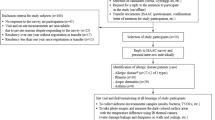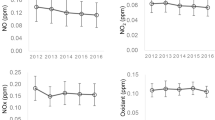Abstract
The hypothesis that attendance at indoor chlorinated swimming pool is a risk factor for irritative ocular and respiratory symptoms and bronchial asthma is well known in literature, although epidemiological evidence is still inconclusive. The aim of this study was to evaluate the association between airborne trichloramine (NCl3) levels and irritative symptoms in swimming pool employees in order to obtain detailed data regarding dose-response relationships and to identify the airborne NCl3 exposure level, if any, without health effects. A total of 20 indoor swimming pools in the Emilia Romagna region of Italy were included in the study. Information about the health status of 128 employees was collected using a self-administered questionnaire. Exposure to airborne NCl3 was evaluated in indoor swimming pools by a modified DPD/KI method. The results of the study evidenced a mean value of airborne NCl3 of 0.65±0.20 mg/m3 (ranging from 0.20 to 1.02 mg/m3). Both ocular and upper respiratory symptoms, in particular red eyes, runny nose, voice loss and cold symptoms, were declared more frequently by lifeguards and trainers when compared with employees working in other areas of the facility (office, cafe, and so on). Pool attendants exposed to airborne NCl3 levels of >0.5 mg/m3 experienced higher risks for runny nose (OR: 2.91; 95% CI: 1.22–6.93) red eyes (OR: 3.16; 95% CI: 1.46–6.82), voice loss (OR: 3.56; 95% CI: 1.60–7.95) and itchy eyes (OR: 2.23; 95% CI: 1.04–4.78) than other employees. Moreover, red eyes, itchy eyes, runny nose and voice loss are related to airborne NCl3 levels, with strong dose-response relationships. In conclusion, this study shows that lifeguards and trainers experience ocular and respiratory irritative symptoms more frequently than employees not exposed. Irritative symptoms become significant starting from airborne NCl3 levels of >0.5 mg/m3, confirming that the WHO-recommended value can be considered protective in occupational exposure to airborne NCl3 in indoor swimming pools.
This is a preview of subscription content, access via your institution
Access options
Subscribe to this journal
Receive 6 print issues and online access
$259.00 per year
only $43.17 per issue
Buy this article
- Purchase on Springer Link
- Instant access to full article PDF
Prices may be subject to local taxes which are calculated during checkout
Similar content being viewed by others
References
Weisel C.P., Richardson S.D., Nemery B., Aggazzotti G., Baraldi E., and Blatchley III E.R., et al. Childhood asthma and environmental exposures at swimming pools: state of the science and research recommendations. Environ Health Perspect 2009: 117: 500–507.
Héry M., Hecht G., Gendre J.C., Hubert G., and Rebuffaud I. Exposure to chloramines in the atmosphere of indoor swimming pools. Ann Occup Hyg 1995: 39: 427–439.
Li J., and Blatchley III E.R. Volatile disinfection by-product formation resulting from chlorination of organic-nitrogen precursors in swimming pools. Environ Sci Technol 2007: 41: 6732–6739.
Weaver W.A., Li J., Wen Y., Johnston J., Blatchley M.R., and Blatchley III E.R. Volatile disinfection by-product analysis from chlorinated indoor swimming pools. Water Res 2009: 43: 3308–3318.
Massin N., Bohadana A.B., Wild P., Hery M., Toamain J.P., and Hubert G. Respiratory symptoms and bronchial responsiveness in lifeguards exposed to nitrogen trichloride in indoor swimming pools. Occup Environ Med 1998: 5: 258–263.
Lèvesque B., Duchesne J.F., Gingras S., Lavoie R., Prud’Homme D., Bernard E., Boulet J.F., and Ernst P. The determinants of prevalence of health complaints among young competitive swimmers. Int Arch Occup Environ Health 2006: 80: 32–39.
Bernard A., Carbonnelle S., Michel O., Higuet S., De Burbure C., Buchet J., Hermans C., Dumont X., and Doyle I. Lung hyperpermeability and asthma prevalence in schoolchildren: unexpected associations with the attendance at indoor chlorinated swimming pools. Occup Environ Med 2003: 60: 385–394.
Bernard A., Carbonnelle S., de Burbure C., Michel O., and Nickmilder M. Chlorinated pool attendance, atopy, and the risk of asthma during childhood. Environ Health Perspect 2006: 114: 1567–1573.
Jacobs J.H., Spaan S., van Rooy G.B., Meliefste C., Zaat V.A., Rooyackers J.M., and Heederik D. Exposure to trichloramine and respiratory symptoms in indoor swimming pool workers. Eur Respir J 2007: 29: 690–698.
Goodman M., and Hays S. Asthma and swimming: a meta-analysis. J Asthma 2008: 45: 639–649.
Font-Ribera L., Kogevinas M., Zock J.P., Nieuwenhuijsen M.J., Heederik D., and Villanueva C.M. Swimming pool attendance and risk of asthma and allergic symptoms in children. Eur Respir J 2009: 34: 1304–1310.
Font-Ribera L., Villanueva C.M., Nieuwenhuijsen M.J., Zock J.P., Kogevinas M., and Henderson J. Swimming pool attendance, asthma, allergies and lung function in the ALSPAC cohort. Am J Respir Crit Care Med 2011: 183: 582–588.
Fantuzzi G., Righi E., Predieri G., Giacobazzi P., Mastroianni K., and Aggazzotti G. Prevalence of ocular, respiratory and cutaneous symptoms in indoor swimming pool workers and exposure to disinfection by-products (DBPs). Int J Environ Res Public Health 2010: 7 (4): 1379–1391.
Chen L., Dang B., and Mueller C., et al. Health Hazard Evaluation Report: Investigation of Employee Symptoms at an Indoor Waterpark. US Department of Health and Human Services, CDC, National Institute for Occupational Safety and Health, Cincinnati, OH, 2008. Report no. HETA2007-0163-3062.
Centers for Disease Control and Prevention (CDC). Respiratory and ocular symptoms among employees of a hotel indoor waterpark resort—Ohio, 2007. MMWR Morb Mortal Weekly Rep 2009: 58 (4): 81–85.
Thickett K.M., McCoach J.S., Gerber J.M., Sadhra S., and Burge P.S. Occupational asthma caused by chloramines in indoor swimming-pool air. Eur Respir J 2002: 19: 827–832.
European standard EN ISO 7393-2. Water quality - Determination of free chlorine and total chlorine - Part 2: Colorimetric method using N, N-diethyl-1,4-phenylenediamine for routine control purposes, 2000.
Predieri G., and Giacobazzi P. Determination of nitrogen trichloride (NCl3) levels in the air of indoor chlorinated swimming pools: an impinger method proposal. Int J Env Anal Chem 2012: 92: 645–654.
Parrat J., Donzé G., Iseli C., Perret D., Tomicic C., and Schenk O. Assessment of occupational and public exposure to trichloramine in Swiss indoor swimming pools: a proposal for an occupational exposure limit. Ann Occup Hyg 2012: 56 (3): 264–277.
World Health Organization. Guidelines for Safe Recreational-Water Environments, Vol. 2, Swimming Pools, Spas and Similar Recreational-Water Environments. World Health Organization, Geneva, 2006.
de Marco R., Cappa V., Accordini S., Rava M., Antonicelli L., Bortolami O., Braggion M., Bugiani M., Casali L., Cazzoletti L., Cerveri I., Fois A.G., Girardi P., Locatelli F., Marcon A., Marinoni A., Panico M.G., Pirina P., Villani S., Zanolin M.E., and Verlato G. for the GEIRD study group. Trends in the prevalence of asthma and allergic rhinitis in Italy between 1991 and 2010. Eur Respir J 2012: 39 (4): 883–892.
Acknowledgements
This study was supported by a grant from the Italian Ministry of Work (no. 1299, 2006). We are also grateful to the town councilors and all of the staff at the participating swimming pools for their support and collaboration.
Author information
Authors and Affiliations
Corresponding author
Ethics declarations
Competing interests
The authors declare no conflict of interest.
Rights and permissions
About this article
Cite this article
Fantuzzi, G., Righi, E., Predieri, G. et al. Airborne trichloramine (NCl3) levels and self-reported health symptoms in indoor swimming pool workers: dose-response relationships. J Expo Sci Environ Epidemiol 23, 88–93 (2013). https://doi.org/10.1038/jes.2012.56
Received:
Accepted:
Published:
Issue Date:
DOI: https://doi.org/10.1038/jes.2012.56
Keywords
This article is cited by
-
Environmental health aspects and microbial infections of the recreational water
BMC Public Health (2023)
-
Comparison of sampling collection strategies for assessing airborne trichloramine levels in indoor swimming pools
Environmental Science and Pollution Research (2022)
-
Impact of swimming pool water treatment system factors on the content of selected disinfection by-products
Environmental Monitoring and Assessment (2020)



